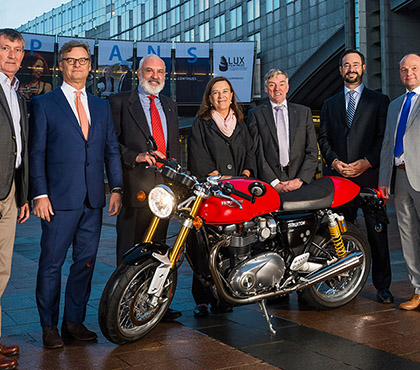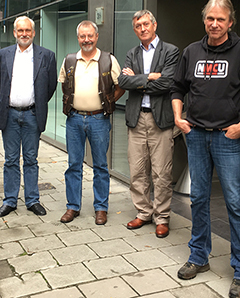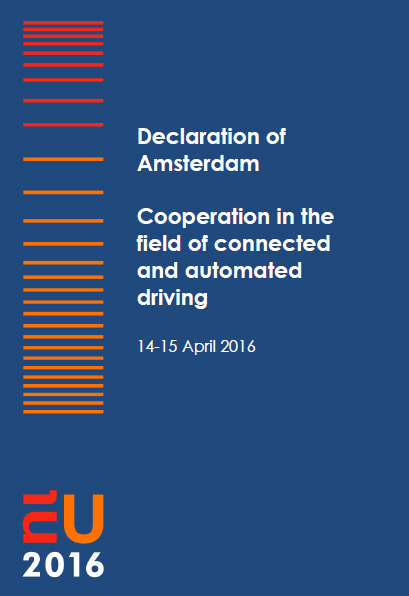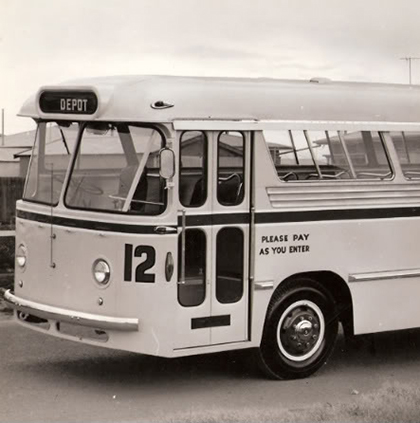 Europe – The FIM Dinner Debate 2016 “Sharing the Road with Robots: When Motorcycling Meets Automation” took place in Brussels on 19th October 2016.
Europe – The FIM Dinner Debate 2016 “Sharing the Road with Robots: When Motorcycling Meets Automation” took place in Brussels on 19th October 2016.
Representatives from the motorcycling community, the industry and EU decision-makers exchanged over the future interaction between automated vehicles and powered two-wheelers, stressing the need to make roads safer for all transport modes. FIM announced during the evening its intention to join the Connected Motorcycle Consortium (CMC).
The event was hosted by two influential Members of the European Parliament, Mr Wim van de Camp (EPP, NL) and Mrs Inés Ayala Sender (S&D, ES), who opened the debate by depicting the great safety potential of Intelligent Transport Systems for motorcyclists but also the importance for politicians to strike the right balance between supporting innovation and avoiding safety hazards.
Mr Jos Driessen, FIM Board Member, welcomed the participants on behalf of the FIM and underlined the importance of a science based approach to road safety. He stressed that FIM promotes this in the same way it uses a science based approach to safety in sports.
Mr Antony Lagrange, coordinator of the European Commission GEAR 2030 “Highly automated and connected vehicles” Working Group outlined the need to act quickly, given the fact that autonomous driving systems are already being introduced on the market, together with as many stakeholders from the value chain as possible, and right, increasing general safety levels for all road users.
Mr Hennes Fischer from Yamaha (member of the CMC), ACEM ITS committee chairman and former FIM World record holder on speed over distance at 100 km and 1.000 km in 1981, echoed the importance of connectivity, demonstrating how this will be key to securing swiftly road safety benefits at a reasonable cost for all motorcyclists.
This view was supported by FIM’s Director of Public Affairs Commission, Mr. Jesper Christensen, who highlighted the important, quick changes in the technological and commercial landscape and the need to put motorcycles at the heart of these new developments.
The dinner ended with a lively Q&A session, stressing the differences between detection and recognition, the future challenges of “coding ethics” into automated vehicles and the need to be realistic and transparent about self-driving technologies.
In his closing remarks, Mr Steve Aeschlimann, FIM Executive Director Operations, thanked all participants for their contribution, reiterated the need to have inclusive dialogue on such matters as all users share the same roads. He outlined that for this purpose, FIM intends to become an associated member of the Connected Motorcycle Consortium.
Mr Silvio Manicardi, FIM Europe Vice-President commented: “The annual Dinner Debate has shown as usual the need for such discussion to enlarge the awareness among all parties and to explain the riders’ position on the delicate subject of automation. We want EU decision-makers to make sure that PTW-users are included in the discussion to increase road safety for all”.
Coordination meeting between FIM Europe and FEMA
 On October 20th the planned meeting between FIM Europe and FEMA (Federation of European Motorcyclists Associations) was held at Brussels, in Belgium, in the context of the initiatives aimed to coordinate intervention and communication strategies about the many topics being discussed at European level and with a focus on mobility and to security (safety).
On October 20th the planned meeting between FIM Europe and FEMA (Federation of European Motorcyclists Associations) was held at Brussels, in Belgium, in the context of the initiatives aimed to coordinate intervention and communication strategies about the many topics being discussed at European level and with a focus on mobility and to security (safety).
The meeting was attended for FEMA by Morten Hansen, the Secretary General Dolf Willigers, Rolf Frieling and the Communications Officer Wim Taal and for FIM-Europe by Vice President Silvio Manicardi, Jesper Christensen and John Chatterton-Ross.
During the meeting, the new Working Group Chairman was elected for the upcoming 12 months, that is till October 2017: Morten Hansen of FEMA is succeeding to Jesper Christensen of FIM.
The PTW sector must confront daily limitations and prejudices that can restrict their circulation or even make it more dangerous.
Some examples are the initiatives to stop the circulation of a high number of PTWs in Paris, the intensive use of cable barriers in Sweden and the rapid development of autonomous driving, with the risk of not properly considering motorcyclists, with all possible dramatic consequences.
“FEMA and FIM Europe, representing 37 million users of motorcyclists in Europe (sic), have been carrying out for a long time their concerns with various stakeholders that operate in Brussels”, stated Silvio Manicardi, FIM Vice President Europe. “I appreciate the sense of cooperation and friendship of all the members of the Working Group to achieve the common goals.”
Motorcycle Minds Comment – Excellent news! This level of lively dinner debate is great and as we know, some of the best debates are in a relaxed atmosphere.
Also good to hear is that the coordination between FIM Europe and FEMA continues for another year on specific issues affecting all motorcyclists whether members of FEMA’s national organisations or FIM Europe.
The Declaration Of Amsterdam – Automated Driving
 As we do at Motorcycle Minds, we pick up and sniff out the snippets relating to motorcycling and in this case on connectivity and automation which is a lot more than just a snippet. The Transport Ministers of the governments of Europe have met (April 2016) and signed a deceleration – Declaration of Amsterdam – pdf – 265kb – which states:
As we do at Motorcycle Minds, we pick up and sniff out the snippets relating to motorcycling and in this case on connectivity and automation which is a lot more than just a snippet. The Transport Ministers of the governments of Europe have met (April 2016) and signed a deceleration – Declaration of Amsterdam – pdf – 265kb – which states:
“It lays down agreements on the steps necessary for the development of self-driving technology in the EU. In this document the Netherlands, the European Commission, EU member states and the transport industry pledge to draw up rules and regulations that will allow autonomous vehicles to be used on the roads.”
Some “snippets” from the declaration:
- Further automation of vehicles and advances in information and communication technologies provide excellent opportunities to improve traffic flows and to make transport safer, cleaner and easier.
- Connected includes cooperative driving: communication between vehicles and also with the infrastructure (C-ITS). Automated driving refers to the capability of a vehicle to operate and manoeuvre independently in real traffic situations, using on-board sensors, cameras, associated software, and maps in order to detect its surroundings. In the medium to long-term, automated driving functions will be expanded with the help of connectivity. Automated includes highly-automated and the development towards driverless vehicles.
- There are important questions to be answered regarding security, social inclusion, use of data, privacy, liability, ethics, public support and the co-existence of connected and automated vehicles with manually controlled vehicles.
- Member States support the development of connected and automated driving through a range of initiatives, such as truck platooning, autopilot on the highway and the establishment of ITS-corridors.
- It is important to manage societal expectations, to raise awareness and increase acceptance and appreciation of connected and automated vehicle technologies.
- An important priority is to ensure that the Vienna and Geneva Conventions on Road Traffic allow the use of connected and automated vehicles on public roads, and to consider a revision of vehicle and traffic safety regulations within this context.
As the Vienna Road Traffic Convention and its predecessor the Geneva Convention, applied by most EU Member States, states that “Drivers shall at all times be able to control their vehicle or guide their animals. When approaching other road users, they shall take such precautions as may be required for the safety of the latter.”
An amendment in 2014 has made space for cars that run without a driver’s full control, as long as a human can still shut off the vehicle.
As the text in Amending these conventions states: “The driver’s obligation to monitor and control any kind of action taken by a vehicle system is addressed by the guiding principle underlying all road traffic rules. The systems are not designed to overrule decisions taken by sane, accountable drivers.”
One could say that any sane accountable debate is now only part of the European Governments’ commitment to introduce full automated systems on open roads; systems that are forging ahead and already on the road in test and commercial terms. Perhaps these are way ahead of the compatible technology as well as compatibility with other vulnerable road users.
Gear 2030 & Motorcycling
 Discussions on such issues can be found in the – GEAR 2030 Discussion Paper Roadmap on Highly Automated and connected vehicles – from the European Commission where at least this “caveat” is stated:
Discussions on such issues can be found in the – GEAR 2030 Discussion Paper Roadmap on Highly Automated and connected vehicles – from the European Commission where at least this “caveat” is stated:
“For fully autonomous vehicles, the vehicle would need to be fully programmed to respect all the specific obligations and safety considerations that are set out in the different traffic laws.
This includes guarantees for the safety both of those inside and of those outside of the vehicle and in all scenarios including interaction between manually driven and automated vehicles and between automated vehicles and vulnerable road users.”
Motorcyclists are classed as vulnerable road users and now this vulnerable road safety issue is being queried in public by some rider organisations in Europe:
NMCU Norway – after the motorcycle of a young, female rider was hit hard from behind by a Tesla, with its ‘autopilot’ in the ON position –
MAG Netherands – Motorrijders Actie Groep Nederland (MAG NL) with Koninklijke Nederlandse Motorrijders Vereniging (KNMV) who demand – “that no vehicles are allowed on our roads that are not properly tested and tested with all kind of two-wheelers, including motorcycles“. Overall asking how these systems will effect motorcyclists and indeed what testing has been completed by these commercial “global” providers of “automated” vehicles.
NMCU and MAG Netherlands are both member organisations of FEMA – Federation of European Motorcyclists Associations
It is not just European rider organisations that are raising concerns, the Motorcycle Riders Foundation (MRF) in the USA, maintains that its federal authorities must, “require robust testing with regard to motorcycle recognition and responsiveness. Given their smaller profile on the road, it’s a valid concern for many bikers. In addition, the MRF insists the Department of Transport (DoT) must ensure that electronic security systems have strong standards to ensure safety and security precautions eliminate risks to motorcyclists. In addition, clear liability of fault must be established when it comes to crashes, and in doing so, motorcyclists should not face unfair advantages.”
In Australia the Motorcycle Council of NSW (New South Wales) responded earlier this year to Driverless Vehicles in a parliamentary committee, highlighting the present technology, “There is no indication that the technology used in driverless cars is able to detect motorcycles as equally well as other vehicles, in fact indications are that the technology is less likely to detect motorcycles, bicycles or pedestrians at all.” mentioning that their Transport Minister hit an inflatable kangaroo during a media demonstration of a driverless vehicle technology”
In true “Aussie” style they say, “Ultimately if you don’t wish to drive, just catch a bus” (more on that later…)
The GEAR 2030 Discussion Paper also lays out that the European Commission are expanding the funding for research on connected and automated driving with a budget of more than 114 million euros with an emphasis placed on large scale demonstration pilots to test the reliability and safety of automation technologies for cars, trucks and fully automated urban road transport systems in real traffic situations.
So that is a large amount of funding to get a voice heard as automation progresses.
Other Needs
 However back to “snippets” and the governments of Europe in the Declaration of Amsterdam. “They” have an opinion that:
However back to “snippets” and the governments of Europe in the Declaration of Amsterdam. “They” have an opinion that:
- there may be societal benefits beyond the aforementioned goals, in terms of social inclusion, improved mobility services in rural areas and cities, the development of mobility as a service and lower travel costs.
- extra flexibility in door-to-door mobility
- Recognising also the long-term potential for social inclusion and increased mobility in remote areas
- reduction of environmental impact and to support seamless door-to-door transport for people
- reduce the environmental impact of road transport
However as FIM and FEMA have already pointed out on various occasions, all this is available right now in the present in the form of the Powered Two Wheeler (PTW – Motorcycle – Scooter – Moped).
Motorcycle Minds, Elaine Hardy, known for siding towards social inclusion, comments, “This is an elitist dream for those that have more money than brains and also a great source of money for “more research” (see above – EU funding of 114 million Euros) .
What ever happened to buses and trains? Possibly the only policy in terms of providing better urban road transport that I could agree with is the nationalisation of public transport – or – rather than spending hundreds of millions of Euros on research relating to autonomous vehicles, why doesn’t the EU offer cheap transport for the masses? That’s the solution.
Surely getting people onto public transport, improve public transport, make public transport more affordable and available – that way it serves two purposes – everybody gets to travel cheaply and you can talk to people, instead of sitting in a car all alone, wasting valuable resources and playing Pukeyman. No?
As an example of the inequality throughout Europe, in Italy a train fare from Bologna to Pesaro (Adriatic) costs 10 Euros, note that the Ferrovia dello Stato (Italian railways) is state owned. A similar distance in the UK (Rugby to London) costs nearly £100. The railways are privately run in the UK. In the UK, the suggestion of nationalisation is on back the table.
With regards automated cars for the elite in whatever country – why waste all that money on this crap when you could build all those ecologically friendly buses or improve the railway systems for all of society?” Finally, if people are so inclined to want personal transport, the simple scooter or motorcycle is still the preferred option for many, especially those who are economically disadvantaged. It’s all a matter of balance”.
Last but not least a statement from the launch of the Amsterdam declaration, “Together, the member states will remove obstacles hampering the introduction of connected and automated vehicles.” let’s hope not or rather, let’s hope that those obstacles do not include motorcycles as major car manufacturers all have or are developing autonomous driving technologies, coupled with political will.
Our thanks to FIM Europe for giving us the opportunity to let our views to be known as the tide of automation development, practice and its introduction sweeps ever onwards.
Declaration of Amsterdam – April 14, 2016
An insurance company away ahead on litigation
No Room For A Rider
Information
The photo call outside the European Parliament in Brussels was supported this year by Triumph Motorcycles Ltd.
FIM Europe – www.fim-europe.com



Ethical Dilemma of Self-driving Cars – Using motorcycles/riders in the question – “How should the car be programmed if it encounters an unavoidable accident?”
https://ed.ted.com/lessons/the-ethical-dilemma-of-self-driving-cars-patrick-lin